

The Grangetown men who died at the Somme
On 1st July 1916, the British Army suffered its largest number of casualties in one day - nearly 55,000, including 20,000 deaths. The first battle of the Somme carried on for four months. In those first few days though, 18 men from Grangetown died. Here are a few of their stories.
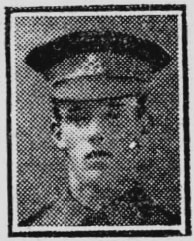 Private Frank Gillespie was your typical Grangetown soldier in many ways. He was 22 years old and newly married when he was sent to France for the final time. He lived with his parents in Knole Street – number 36 – and worked down at the Docks. There was an engineering firm called Loveridge in Hannah Street which made equipment for ships and he was a smith’s striker. Hot work.
Private Frank Gillespie was your typical Grangetown soldier in many ways. He was 22 years old and newly married when he was sent to France for the final time. He lived with his parents in Knole Street – number 36 – and worked down at the Docks. There was an engineering firm called Loveridge in Hannah Street which made equipment for ships and he was a smith’s striker. Hot work.
He was the eldest of 10 brothers and sisters, the son of a Somerset man who had also worked in the shipyards. Frank enlisted as soon as he could at the start of the war as a 20 year-old. He joined the South Staffordshire Regiment. He had been invalided home twice, before the Battle of the Somme. Frank married around the time his baby daughter Ellen was born in March 1916 but he was soon forced to leave his wife Agnes at home and was back over to France.
The South Staffs were in the 7th Division, 91st brigade – and part of a diversionary attack on Gommecourt, north of the main Somme battle early on the morning of Saturday 1st July. The Germans were well dug in to withstand the artillery barrage and responded with machine gun and rifle fire. Frank was one of those missing presumed dead.
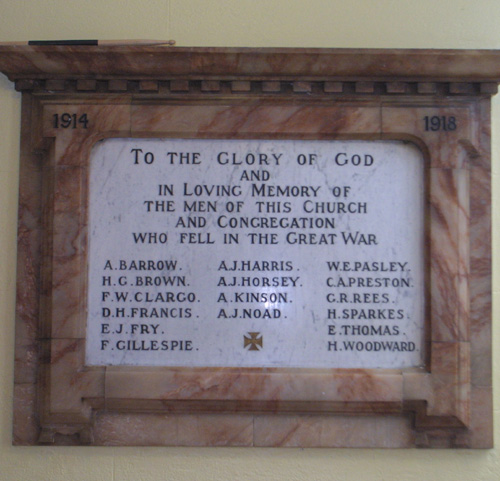
As well as on the Grange Gardens memorial he was remembered on the Grangetown Baptist church memorial. Agnes his widow remarried in 1923. The daughter who never knew him moved to the United States and died 10 years ago.
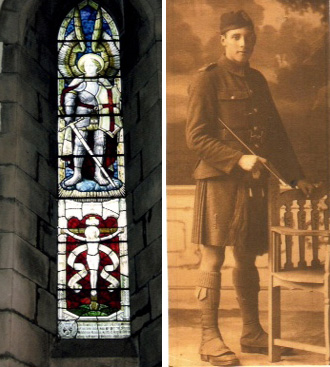
The window unstalled in memory of Pte Percy Henderson. Click on image for greater detail.
Private Percy Storey Henderson was the only son of Priscilla Stone Henderson, of "Tynedale", 67 Pentrebane Street - overlooking Grange Gardens - and Robert Storey Henderson (d 1921), once a ship repairers' clerk and then of Lloyd and Henderson's builders and contractors.
Percy joined the London Regiment (London Scottish) "B" Coy. 1st/14th Battalion, which was in action east of Hebuterne – another offensive to the north of the Somme valley. Mines had been left under German wires late at night and exploded. The attack started at 7.30am but the smoke used to confuse the enemy was thicker than in practice and those involved found it was hard to keep direction. Percy's company was under the command of Major Francis Lindsay, a London civil servant before the war. B Company's entry in the battalion diary reads: “Occupied objective assigned to them by 7.45am – and consolidation began and work of blocking Fable (trench). This was interfered with by German bombing attacks, which were driven off.”
Early on there were 50 casualties in his unit alone. By 2pm, they were under “severe pressure” on both flanks and withdrew to Fall trench. “Severe losses were inflicted by enemy rifle, some of whom wore a green uniform” reads the diary entry for B company. Major Lindsay himself was killed walking back. Captain Sparks assumed command and said he was left with three alternatives – to stay and be killed, to surrender or withdraw. With the first two “distasteful to me,” he picked the latter. The captain had to stay in a shell hole 50 yards from the enemy line for four hours.
Percy was killed during this attack - either in the early morning or during the heavier losses later. But the death toll was devasating. Altogether in the Battalion of 23 officers and 811 ordinary ranks, only nine officers survived – and 256 men.
Percy had worked as an accountant for James Llywellyn Colliery Proprietors in Cardiff Docks and was "exceedingly popular amongst a wide circle of friends," according to his obituary. There is a stained glass window to his memory in St Paul's Church, where he was a regular worshipper. It carries a quote from the Gospel of St John – Greater love hath no man than this, than a man lay down his life for his friends.” The window by Burlison & Grylls shows a figure of St Michael in armour.

Another casualty of July 1st, Private Henry Riddick would die of his wounds two days later in a military hospital in Rouen. He was just 19.
Henry was the youngest of five sons born in Bedminster, Bristol, but his widowed mother Emily for many years lived in Stoughton Street – now Jubilee Street in Grangetown. (Later that house would be demolished after bomb damage in the 1941 Blitz). Like his late father Tom and his older brother Edward, Henry was down the coal mines by the age of 14 near Pontypool.
When war came he joined the Somerset Light Infantry 8th Battalion, which at the time of the Somme was part of the 21st Division (63rd brigade) attacking the village Fricourt. There was a newly dug frontline trench known as Shuttle Lane. At 7.30am - like thousands for miles along the front line - the soldiers of B and C company crawled out.

The Somerset Light's position on 1st July can be seen near the top left of this battle map
Unlike some other notes of the battle, the 8th battalion diary gives a pretty vivid account. They were ordered to advance in four lines - at intervals of two paces:
"When the artillery barrage lifted, our men advanced in quick time. They were met by very heavy machine gun fire and although officers and men were being hit and falling everywhere, the advance went steadily on, and was reported to by a brigade major who witnessed it to have been magnificent.“The leading platoons lost quite 50% going across No Man's Land. On arrival near the enemy's front line, they were momentarily held up by a machine gun but as the successive supporting lines came up they soon got in. Already the enemy had opened an artillery barrage on 'no man's land' and our front line trench which caused heavy casualties among the supports.
“The only enemy found alive in this front line were a few machine gunners who were immediately killed."
They found German communication trenches "battered beyond recognition" and a "mass of craters" and moved towards Lozenge Alley. Henry is buried with 3,000 casualties of the hospitals and military camps.
The date which is etched on the history books in terms of Welsh soldiers is the 7th July – the start of the phase of the battle which saw the assault on Mametz Wood. But there was fighting elsewhere along the line and over many days and what would turn into weeks.
Private Maurice Harris was killed on Friday 7th July.
It’s been interesting and quite complicated looking into his family history, one which was filled with plenty of sadness. Maurice was brought up in Avoca Place by father Walter and his wife Carrie. The family moved to Rochdale in Lancashire and had a daughter in 1904 but Carrie, Maurice’s mother died in 1907, aged 35. Walter remarried Ada Hargreaves a year later – she already had a child – and the couple soon had two more children Nellie and Gwen. The youngest daughter would die during the war, while still a toddler.
At some point, Maurice moved back to Cardiff and worked at Navigation Paint Works at the Penarth harbour end of Ferry Road. He lived with Walter’s sister Constance Elliott – a mother of 14 - eight children survived - who was married to a gas works labourer and lived in North Street. His aunt was named as his next of kin.

And Maurice's moved back to Cardiff may well be because his father joined up with the Manchester Regiment and was away fighting in the war himself.
But an interesting document which comes from Walter’s own service record (above) reveals Maurice's age. He was born on 13th May 1900. This would make him 15 when he joined up and barely 16 when he was killed on the Somme.
Like his father, Maurice joined a north west regiment - who bore heavy losses during the Somme. Maurice was with the 10th Lancashires (17th Northern Division, 52nd Brigade) who were involved in an attack in the early hours of the 7th July, coming under machine gun fire - some got as far as Pearl Alley and reached the outskirts of Contalmaison village but faced a counterattack, alongside the Worcestershire Regiment. It was eventually captured on 10th July - altogether a total of more than 18,000 casualties.
On nearing Quadrangle support trench, the Battalion was received with heavy rifle and machine gun fire and driven back," reads the battalion diary entry.
Maurice was reported missing before his death was confirmed the following March. Like many, his body was never recovered. He lost an uncle in the war too - back in hospital in Cardiff to septicaemia in 1915 - but Walter survived and died in Lancashire aged 72 in 1940.
One of three dead at Mametz from Grangetown on 7th July was Private William Salter who was serving with the 16th Battalion Welsh Regiment, aged 19. His obituary said he lived with his sister at 5 Rutland Street. He had five brothers and sisters and worked at Channel Mills before the war.
Another was Private Arthur Thomas who worked for Cardiff tramsways before the war, but joined the Cardiff Pals battalion in November 1914. He lived in Forrest Street. He was promoted to Lance Corporal. Like many, his body was never recovered but his name was remembered on the Thiepval memorial, as well as back home in Grangetown.
On July 9th, Private James Alfred Farr, aged 18 King's Own Scottish Borderers, 6th Battalion died at the Somme. Here’s James, who lived at 74 Mardy Street, wearing his cap from Court Road School pupil. Born in Dudley, he was employed as a clerk in the goods office at the Great Western Railway and is also on the GWR memorial.
A day later, Sergeant William Martin died aged 38. At this point we start seeing casualties from the 19th Battalion of the Welsh Regiment, which joined the battle on the 7th, but whose attack was forced back initially because of heavy machine gun fire after the failure of the artillery bombardment. He was one of 32 men to die in a three day period.
William lived at 25 Chester Street, with his wife Elizabeth. A South Shields-born dockyard labourer involved in ship repairs, the couple had two young sons. He joined up in December 1915.
Marked on his photo is "still buried in Caterpillar Woods." He is commemorated on the St Patrick's Church memorial plaque too.
A former Grangetown Council School pupil and was a keen athlete (a walker), according to his obituary. There’s a family story that he was killed removing barbed wire during Mametz Wood.
There’s also a letter written by an officer to his widow: "He was a company stretcher bearer and along with his mate did splendid work for the company. They worked like heroes and in spite of very heavy shelling carried wounded men to the Field Ambulance. Pte Rich was the most unselfish worker and I have mentioned him to the commanding officer on three occasions for his good work. He was very much liked by both officers and men."
Another man to die with the 19th Battalion was Private Charles Yorath. His brother David survived while serving in the 16th Battalion, while his step-brother Henry was a sergeant who was injured. Both were well known docks workers. The name Yorath is quite well known and Charles was the great-uncle of the footballer and former Wales manager Terry Yorath and great-great uncle of TV presenter Gabby Logan.
He lived with his widowed mother Clara while their next door neighbour at 60 Hewell Street was Private Thomas Shaw who had died just three days earlier, aged just 20, who was serving in the 16th Battalion. A docks labourer and one of a large family, Thomas left behind a widow and a baby daughter.
Others to died included Private Albert James, another from the Welsh Regiment 19th Battalion, killed on the 12th July at Mametz. He had relatives at 76 Cornwall Street and enlisted in Cardiff at 15 years eight months. He served on the Western Front for 10 months. He’s also commemorated on the St Patrick's Church memorial plaque.
You can a period map of Grangetown, with poppies showing where the Somme soldiers from these few weeks lived – Edgar Watkins, a 42-year-old electrician from Earl Street, who left five children; George Hill, 23, who was the son of a hairdresser who worked in the fruit market. And Evan James – a veteran of the Boer War, where one newspaper said he had "many hairsbreath escapes." Living in Ferry Road with his brother, he joined at the start of the war and died aged 43. He was from Llandovery originally and is also remembered on the war memorial there. The Cambrian News reported after his death: "He visited Llandovery on short leave from the trenches last Christmas. He even then appeared to have a premonition of his coming end. Speaking to a friend on the night before his departure, he remarked: 'Have a good look at my face now, old man. You will never see me again.'" There is a full list of men - and women - who died in World War One from Grangetown here

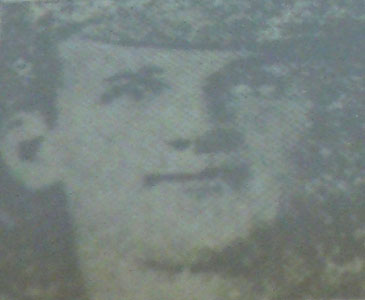
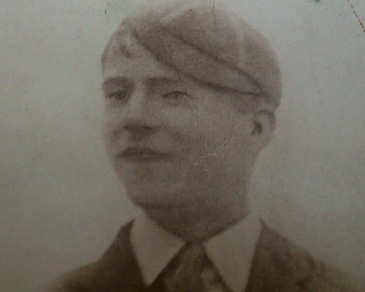
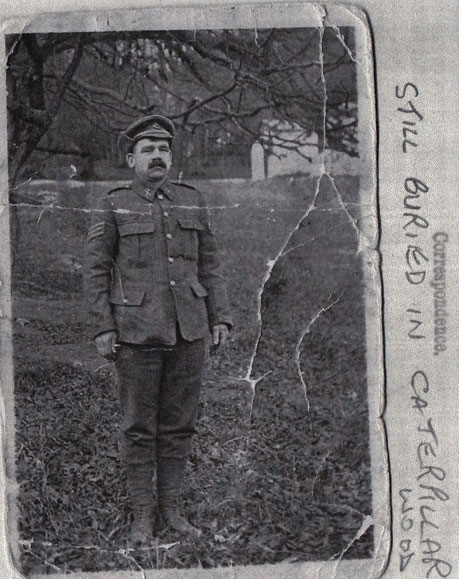
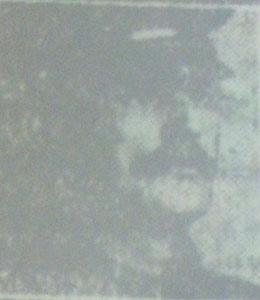 Private Alf Rich was another 19th Battalion volunteer, aged 43, who died that day. A Somerset man he worked for 17 years at Grangetown Gas Works and lived at 50 Wedmore Rd with his wife and five childen.
Private Alf Rich was another 19th Battalion volunteer, aged 43, who died that day. A Somerset man he worked for 17 years at Grangetown Gas Works and lived at 50 Wedmore Rd with his wife and five childen.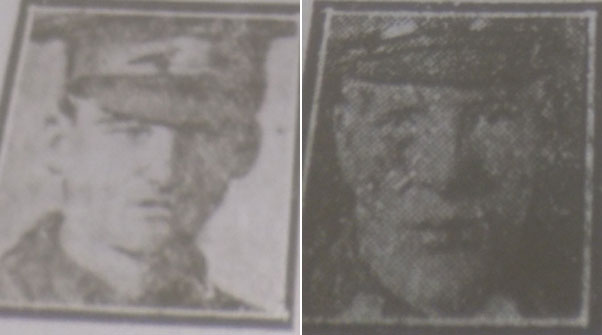
Neighbours Charles Yorath and Thomas Shaw, who died within a few days of each other